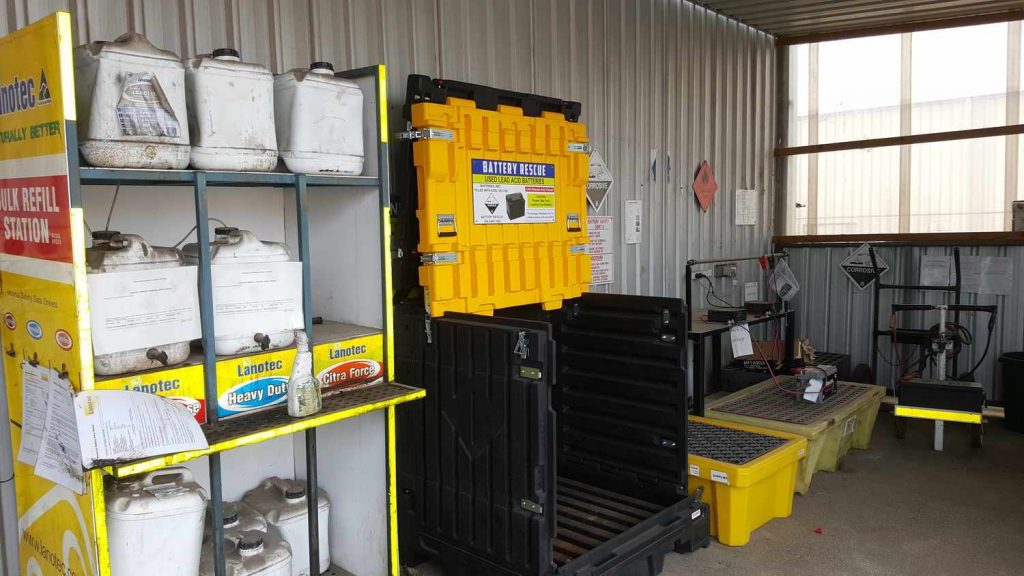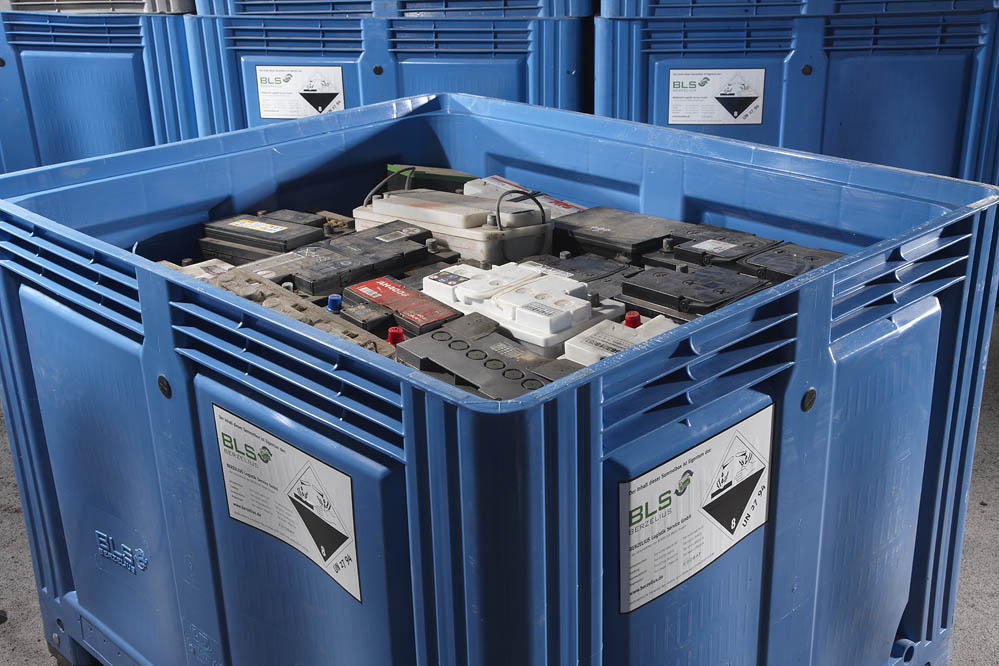Used or Spent Lead acid batteries are considered hazardous because they contain sulfuric acid which contains relatively high levels of entrained lead and other toxic heavy metals. Most car batteries and automobile batteries are lead acid batteries, but they are also used in a range of industrial applications such as UPS backup and solar storage systems.

As a hazardous waste there is a raft of regulations that govern their storage, handling, transportation, and recycling. In this fact sheet we have summarised the US regulations & requirements as they apply to Hazardous Waste Generators such as businesses and organizations that generate their own waste lead acid batteries or acquire them from the public or businesses. Examples include automobile dealerships, auto parts stores, automobile service stations, scrap dealers, salvage yards and waste facilities and many others.
Spent (Used) Lead Acid Batteries Regulations for Generators
The 3 main Federal Regulations that relate to the safe management of used or spent lead acid batteries, are;
- The Environmental Protection Agency’s (EPA) Hazardous Waste Regulations, regulated under Subtitle C of the Resources Conservation and Recovery Act (RCRA). Subtitle C regulations set the requirements for hazardous waste generators, transporters, and treatment, storage and disposal facilities. This includes permitting requirements, enforcement and corrective action or cleanup.
- Department of Transport (agency of the Pipeline and Hazardous Materials Safety Administration) establishes the requirements and are responsible for the safe transportation of hazardous materials.
- The Department of Labour’s agency, Occupational Safety and Health Administration (OSHA), establish the requirements for safe and healthful working conditions, including safe practices for handling hazardous materials.
Many of the above Federal Regulation have been enacted at the state level, however some State regulations may include additional requirements. It is therefore important the Battery Generators check their state regulations in addition to the Federal requirements.
1. EPA Hazardous Waste Requirements for Spent Lead Acid Batteries
EPA’s federal universal waste regulations streamline the hazardous waste management standards for certain categories of hazardous waste, including batteries https://www.epa.gov/hw/universal-waste. However, used or spent lead acid batteries that are being managed under the EPA’s requirements specified in 40 CFR part 266 subpart G for “Spent Lead Acid Batteries Being Reclaimed” are not classified as universal waste. For most Battery Generators it would make sense to manage your used battery disposals under these requirements, as the regulatory requirements are less onerous.
The table in subpart G §266.80 outlines the requirements for Battery Generators storing used or spent lead acid batteries to be collected for recycling (reclamation). An excerpt of the table is shown below with the 2 categories that will generally apply to most Battery Generators. Note the requirements are the same for both (so don’t think too hard about which one applies to you);
| If your batteries . . . | And if you . . . | Then you . . . | And you . . . |
| (2) Will be reclaimed other than through regeneration | generate, collect, and/or transport these batteries | are exempt from 40 CFR parts 262 (except for §262.11), 263, 264, 265, 266, 270, 124 of this chapter, and the notification requirements at section 3010 of RCRA | are subject to 40 CFR parts 261 and §262.11, and applicable provisions under part 268. |
| (3) Will be reclaimed other than through regeneration | store these batteries but you aren’t the reclaimer | are exempt from 40 CFR parts 262 (except for §262.11), 263, 264, 265, 266, 270, 124 of this chapter, and the notification requirements at section 3010 of RCRA | are subject to 40 CFR parts 261, §262.11, and applicable provisions under part 268. |
Note: A Reclaimer is a business that recycles the used lead acid batteries.
Below are the relevant provisions that apply, as defined by the table above:
Used (spent) lead acid batteries destined for reclamation (recycling) are exempt from many of the provisions in PART 261 “IDENTIFICATION AND LISTING OF HAZARDOUS WASTE”. Under Subpart C “Characteristics of Hazardous Waste”, and the definition laid out in §261.22 “Characteristic of Corrosivity”, used lead acid batteries meet this definition and hence the Hazardous Waste Number D002 applies.
Applicable provisions from PART 262—STANDARDS APPLICABLE TO GENERATORS OF HAZARDOUS WASTE, §262.11 Hazardous waste determination and recordkeeping, are items f) and g), which require:
(f) Recordkeeping for small and large quantity generators. Records must be maintained for at least three years from the date that the waste was last sent to on-site or off-site treatment, storage, or disposal.
(g) Identifying hazardous waste numbers for small and large quantity generators. Prior to shipping the waste off site, the generator also must mark its containers with all applicable EPA hazardous waste numbers (EPA hazardous waste codes) according to §262.32*. The applicable Hazardous Waste Number for spent lead acid batteries is D002.
* There appears to be a contradiction here, as Generators of Used Lead Acid Batteries are suppose to be exempt from Parts 262, except for the requirements of §262.11, which then makes reference to §262.32.
Specifies which wastes are prohibited from land disposal. §268.37 prohibits waste with corrosive characteristics such as spent Lead Acid Batteries being disposed to landfill.
What are the Regulations for Storing Used Lead Acid Batteries / Car Batteries?
The specific requirements for storing your batteries may vary from state to state, however the same general principals will usually apply. The used or spent lead-acid batteries should be stored so that the acid they contain cannot spill or leak into the environment. The batteries should be stored upright so that acid cannot leak out of the top vent holes.
Note that the batteries can be stacked on top of each other, but no more than 4 layers high, so the stack remains stable. Precautions should be taken to prevent the terminals from short-circuiting. Stacking undamaged polypropylene (plastic case) batteries, will not create a short-circuit risk, however, take care not to stack steel case batteries (rare) directly on top of battery terminals.
Damaged Batteries, those that are cracked or broken, must be stored and transported in acid proof, closed containers such as a polyethylene bucket or drum.
Battery Generators can store one ton or less of used lead acid batteries for a period of 12 months before shipping to a recycler. If you have more than one ton then you may only store for 180 days. If these times are exceeded the generator is no longer exempt from the regulations for generation, storage and transportation of hazardous waste.
Indoor vs Outdoor Battery Storage
The requirements for indoor storage are less than those for outdoor storage hence it is easier to comply. Also, Outdoor storage can be more prone to cracks and acid leakage due to the batteries freezing.
Both require some form of acid-resistant curbing (bunded area) or a ready made pan or tub (bin / container) that can contain any acid leaks. A suitable curbed area could be constructed from asphalt or concrete, coated with an acid resistant epoxy or acid resistant plastic sheeting, with a frame to create a bunded area.
Outdoor storage may require covering and diking to prevent stormwater contamination. If you are using a tub or container then you will ideally require a lid to prevent rainwater mixing with the acid.
You should label the lead acid battery storage area with “Used Lead Acid Batteries” and display a Corrosive Class 8 diamond and remove spilled or leaked acid often enough that there is no overflow from the curbed storage area and include a sump or depression to help collect any spilled acid
2. DOT’s Requirements for Transporting / Shipping Used Car Batteries
The Department of Transport (DOT) is an agency of the Pipeline and Hazardous Materials Safety Administration (PHMSA). DOT establish the requirements and are responsible for the safe transportation of hazardous materials, under which lead acid batteries (used & new) are classified.
The requirements for Electric storage batteries, containing electrolyte acid or alkaline corrosive battery fluid (new & used) are laid out in the Electronic Code of Federal Regulations, in the Title 49 → Subtitle B → Chapter I → Subchapter C, however for simplification only the provisions for transportation of lead acid batteries by highway or rail, are shown below.
The highway or rail transportation requirements for lead acid batteries can be found in:
PART 173—SHIPPERS—GENERAL REQUIREMENTS FOR SHIPMENTS AND PACKAGINGS,
Subpart E—Non-bulk Packaging for Hazardous Materials Other Than Class 1 and Class 7
The relevant clause is e) and states:
(e) When transported by highway or rail, electric storage batteries containing electrolyte, acid, or alkaline corrosive battery fluid and electric storage batteries packed with electrolyte, acid, or alkaline corrosive battery fluid, are not subject to any other requirements of this subchapter, if all of the following are met:
(1) No other hazardous materials may be transported in the same vehicle;
(2) The batteries must be loaded or braced so as to prevent damage and short circuits in transit;
(3) Any other material loaded in the same vehicle must be blocked, braced, or otherwise secured to prevent contact with or damage to the batteries. In addition, batteries on pallets, must be stacked to not cause damage to another pallet in transportation;
(4) Except for the purpose of consolidating shipments of batteries for recycling, the transport vehicle may not carry material shipped by any person other than the shipper of the batteries; and
(5) Shipments made under this paragraph are subject to the incident reporting requirements in §171.15.
This effectively means that if the requirements of (e) are met that lead acid batteries are exempt from the other requirements of this subchapter, which includes the shipping papers, package marking, labeling, and transport vehicle placarding requirements as well as the testing requirements for packaging and containers used for transporting hazardous materials.
Note:
There are 2 categories of lead acid batteries specified in the Department’s Hazardous Materials Table. They are;
- UN2794 – Batteries, Wet, Filled with acid – Hazard Class 8
- UN2800 – Batteries, Wet, Non-spillable – Hazard Class 8
The requirements of clause e) apply to both types of lead acid batteries when shipping by highway or rail. The definition of UN2800 Non Spillable batteries is only relevant for Aircraft transport.
Packaging used lead acid batteries for transport
Wood pallets
The most common packaging method used for transporting used lead acid batteries destined for recycling is the wood pallet. The Battery Council International (BCI*) provides some excellent guidelines on how to package the different types of lead acid batteries for highway & rail transport.
Video instructions and flyers can be found on their website page.
* BCI is a not-for-profit trade association formed in 1924 to promote the interests of the lead battery industry.
Battery Bins / Containers
The use of plastic battery bins or containers such as those pictured below, for transporting spent car batteries and other lead acid batteries is currently limited in the US. This is primarily because US Recyclers generally prefer the batteries to be delivered on wood pallets and the extra logistics complexity of having to manage the bins or containers return.

That said bin and containers provide some significant benefits for the storage and transport of used lead acid batteries, including;
- Battery electrolyte (acid) leaks are captured and prevented from leaking into the environment. The battery acid as well as being corrosive, contains relatively high levels of lead and other toxic heavy metals
- The stacking and packaging requirements are simpler and safer than those for wood pallets. This is particularly true when storing and packaging many different sized batteries.
- Automatic unloading from the bin or container at the recycler, eliminates any further human intervention, from the Generator to the Recycler.
For these reasons the use of plastic battery bins is widespread in Europe.
Below are our recommendations when using plastic bins or containers to transport spent lead acid batteries. They key requirement of clause (e) is that the batteries must be loaded or braced so as to prevent damage and short circuits in transit.
Used Lead Acid Batteries (ULAB) can pose a fire risk, due to the potential for a short circuit between a battery’s 2 terminals . To eliminate the potential of a short circuit the following procedures should be followed when stacking batteries onto plastics bins or containers
For the majority of batteries, with plastic casing, the risk of short circuits can be eliminated by stacking each battery in a vertical, upright position, whereby the plastic bottom of the battery is resting on the terminals of the underlying battery. Provided the batteries are packed snugly and in the vertical upright position any excessive movement will be prevented and there will be no risk of terminals touching each other and creating the conditions for a short circuit.
The other important precaution is not to include any metal objects that could cause a short circuit. Steel case batteries, while uncommon are particularly dangerous as the steel case can cause a short circuit between the 2 terminals of an underlying battery
For this reason, steel case batteries can never be stacked on top of other batteries where the steel case is resting on top of the underlying battery’s terminals. If possible, we recommend placing them at the bottom of the bin. If this can’t be done due to the battery bin already having a layer(s) of batteries stacked inside, then the steel case battery must be insulated from the underlying battery. The easiest methods to achieve this are:
- Fold a cardboard box (so that it is at least 3cm thick and insert between the steel case and underlying battery terminals.
- Tape the terminals of the underlying battery with a heavy-duty tape.
3. OSHA Requirements for Storage, Handling & Transport of Used Lead Acid Batteries
OSHA establish the requirements for safe and healthful working conditions by setting and enforcing standards. Employers must comply with all applicable OSHA standards and the General Duty Clause of the OSH Act, which requires employers to keep their workplace free of serious recognized hazards.
OSH Act
Section 4(b)(1) of the OSH Act states that OSHA does not have jurisdiction over health and safety if another Federal agency exercises its statutory authority in this area.
U.S. courts interpret the OSH Act using the “gap theory” or “hazard-by-hazard” approach:
So for example if DOT has a regulation that would reduce or eliminate the workplace hazard, DOT regulations apply. And If DOT does not have a regulation to address the hazard, OSHA regulations apply.
OSHA Hazardous Waste
Hazardous waste is addressed in specific OSHA standards for general industry and construction. This section highlights OSHA standards and documents related to hazardous waste, which would apply to the safe storage, handling and transport requirements of spent lead acid batteries.
https://www.osha.gov/hazardous-waste/standards
The following document “Small Entity Compliance Guide for Employers That Use Hazardous Chemicals” provides recommendations as well as descriptions of mandatory safety and health standards.
This link provides a useful summary of OSHA’s jurisdiction pertaining to hazardous waste transportation in the railroad and trucking industries, and discusses the application of key OSHA standards, including:
- Hazardous Waste Operations and Emergency Response (HAZWOPER)
- Recording and Reporting Occupational Injuries and Illnesses
- Personal Protective Equipment (PPE)
- Toxic and Hazardous Substances
- Process Safety Management
- Material Handling
- OSHA’s Draft Proposed Safety and Health Program Rule
Disposing of Used Car Batteries
The recycling of lead acid batteries is one of the great recycling success stories with approximately 99% of all spent lead acid batteries being recycled (reclaimed) in the US. Furthermore nearly 97% of the battery’s components are recycled including the lead, sulfuric acid and polypropylene casing.
One of the reasons for the high recycling rates is that in most US States it is illegal to dispose of lead acid batteries to waste landfill. They must be either recycled or disposed of as a hazardous waste.
The introduction of a core charge that all retailers can charge when selling a car / automobile battery, which is refunded when the old or spent battery is returned, has also ensured high recycling rates. The core charge can be applied in all 50 states and in over 30 states it is now mandatory.
For a summary of the state lead acid battery recycling laws.
Disclaimer
This fact sheet has been compiled based on our interpretation (to the best of our ability) of the relevant US Laws & Regulations, however, may contain errors, omissions or misinterpretations. It is therefore important that businesses or organisation conduct their own research and where appropriate seek legal advice to ensure their compliance with any relevant regulations.
FAQs for Spent Lead Acid Batteries
Spent lead acid batteries destined for recycling are still classified as a Hazardous Waste under the EPA, DOT and OSHA regulations.
They are however exempt from many of the hazardous waste regulations / requirements if destined for recycling or reclaiming, but not all. For the EPA exemptions see above “EPA Hazardous Waste Requirements for Spent Lead Acid Batteries” and for transport exemptions see “DOT’s Requirements for Transporting / Shipping Used Car Batteries”.
Yes they are. They are classified as a Hazardous Waste in the EPA, DOT & OSHA regulations. Their transport requirements, under the DOT Regulations, are the same as wet, lead acid batteries except for air transport.
Yes. While the regulations don’t specifically state this, they are designed to eliminate the danger and environmental impact of the battery electrolyte (acid) leaking into the environment.


